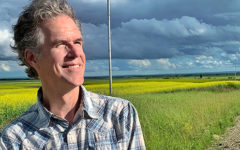
Ask Sonny Anything is a recurring feature where our readers pose questions to the great Sonny Osborne, one half of the iconic Osborne Brothers who redefined bluegrass music in the 1960s, and noted banjo maven and collector of fine prewar instruments. Everyone is encouraged to pose queries of your own each week in the comments, about his history in the music, his wealth of banjo knowledge, or regarding any life advice you might be needing.
Dear Sonny
I have long enjoyed a story I heard about you and Don Reno when you had your buses/RVs parked together at some festival. A stoned-out-of-his-mind hippie stumbled into your area and plunked himself down, uninvited, in a lawn chair belonging to you one or the other of you, and promptly passed out. According to the story you and Don quietly resolved to “thank” this fan, and Don brought out his barber kit and gave the hippie a thorough white sidewalls military haircut while he was unconscious. 1) Is this remotely true, and if so 2) Did anyone observe when the bluegrass enthusiast regained consciousness?
Thanks for your column — as an old-timer I sure enjoy it.
Old Timer
upstate NY
The time you mentioned is all true. Don and I were having a conversation and this guy that neither of us knew just wandered in and sat down on a little cabinet by the door, and in 2 minutes passed out cold. We talked a few more minutes and Don asked if I knew him, I said “No, I thought he was with you.” Don said “Whoever he is, he’s in bad need of a haircut!” So Don, who was an excellent barber, went next door to his motorhome and got his barber tools. Dude had extremely long hair! I found out later the guy who received a Don Reno special haircut was a lawyer from Baltimore. It seems to me that he, or someone who was with him, would realize that we’re talking about their friend, and come forward. But no one has, as of this date. It was so funny… Don would cut awhile and then in his W.C. FIELDS act, back up and frame him, like they do in movies…and then he would say, “I believe he needs a little more off the left side!” To start with, this guy had below shoulder length hair. You’re right with the white wall military style cut. The guy sat there for another 20 minutes, long enough for Don to clean the hair up and put his tools away. He just stood up and stretched, turned and walked out. Never knew it if I ever saw him again. 100% truth.
Thank you for spending time with we hill folk!
s
—–
Hey Sonny, I read somewhere that Doc Waton’s first acoustic guitar recording was with Clarence Ashley at Ashley’s daughter house in Saltville Va . If this is true what was her name? And did Hobart Smith have anything to do with this event?
Mark
Hey Mark. Thanks for contributing.
While I knew and worked many festivals with Doc Watson. I was never considered a close friend as others were. I do know the name Clarence Ashley is connected with Arthel (Doc). I’ve been privy to conversations where Doc mentioned him in reference to his first recordings. In fact, he said his first acoustic recording was with a D18 Martin. My understanding was that it took place at Ashley’s house. A daughter was never mentioned although, as I stated I was just a bystander listening in on this conversation…not a participant. I knew Jack Lawrence and T. Michael Coleman and Doc’s son Merle well. Sorry, that’s all I know.
Thank you Mark.
s
—–
I have loved your banjo playing for a long time. It is different from anybody else’s style. It tickles the ears. I hear humor and sophistication in it, both in your solos and backup. I read where you said that you used to sit on the side of the stage during Merle Haggard’s shows and pay close attention to Roy Nichols Tele playing. I love good Tele playing as much as good banjo playing, myself. Did Roy’s playing affect your approach? Were there other electric guitar players who grabbed your attention or influenced you , as well?
P.S. Thank you for doing this each week. I love it!
Eric Gibson
Eric. Thank you for sharing your time with us. For your information, I’m a fan of your harmony. So pure!
We opened for Merle Haggard for a little over 4 years and I didn’t waste it. I was such a fan of Roy Nichols guitar playing, almost as much as Earl’s banjo playing in the late ’40s and up to the mid ’50s. I made it my quest to become close friends with both. Why? I don’t know other than to try and learn how their thinking worked, and their approach to their respective instruments, and because I really liked both. Earl was here at my house when we had “pickin’ parties,” and I at his house for pickins and just talk… and Roy… I would place a chair behind the curtain as close to him as I could get. I learned so much from him, especially backing a singer, and just his choice of notes. Bluegrass players are so different in that they play background behind a singer all the time he/she is singing. Country pickers fill between vocal lines. That’s where Roy’s playing was so good and I tried to take it all in. To me, and my opinion only, Merle was never the same without “Big Nick.”
We played Dayton, Ohio and before the show I noticed his Fender Twin Reverb amp was really ragged. We had stopped using amps, etc. at that time and I had a relatively new one…exactly like his. I asked if he needed to trade and he said YES. He got my newer amp and I got his old one. I know this sounds corny, but when Roy died it Hurt and when Earl died it Hurt.
I look forward to meeting you sometime Eric. In my opinion, Bluegrass music needed THE Gibson Brothers. Like a deep breath of cool air. Thank you for your kind words.
s
—-
Hi Sonny!
I’ve always loved the Osborne Brothers, especially your harmony. You were one of the first bands I heard that used a high lead with the harmony parts underneath. Can you talk about how you all developed that sound?
Also, did you ever sing lead on any of the songs? I’m a huge fan of tight harmonies, and you all were certainly one of the best! Thanks!
Sean McCormick
Hey Sean.
Good to hear from you. We developed that style harmony for two reasons, although those reasons were not present when we started that style of harmony vocals. We first used that style harmony on the ending of Ruby, Are you Mad on our first release for MGM in 1956. But the song that really made that harmony shine was Once More, a song Dusty Owens had written, and we wanted to record it on the next session. Which we did record, on MGM in 1957 with She’s No Angel on the B side. Shot Jackson played dobro, and that record went to number 11 in National charts.
In the beginning, Bobby, Red Allen, and I were rehearsing in the car. And we were doing it with regular harmony…Lead, Tenor, and Baritone and it was not sounding right. Red was doing the verses and that didn’t sound right. Bobby tried the verses…that didn’t sound right. I mentioned moving the Key to C and let Bobby do the verses and chorus and we put the other parts below him. It worked, but not to Red’s satisfaction. That put him on a low tenor note which he considered that to be sort of a demotion. Bobby lead, and me doing a baritone part, with the other harmony part below that.
The idea hit me that if we could do that on everything it would solve two problems. Bobby could sing where he was meant to sing, and because Bobby’s voice and mine nearly had the identical tone, it wouldn’t matter much who we got to sing the other part, we would always sound the same. (We lucked out though. Benny Birchfield, Dale Sledd, Paul Brewster, Terry Eldredge, Terry Smith, and Daryl Mosely were pretty darn good.) No one singing bluegrass harmony had ever done it just like that. Unknowingly, we, (Ruby and Once More) had created a style of harmony that would follow us throughout our career. And I might add, started a style of vocal harmony that many others used at the time, and even more use it now. Yep. A magic night in Bobby’s ’53 Buick.
—–
Sonny,
I remember seeing you and Bobby in Darrinton, Washington eons ago. For some reason, the main vocal mics went off part way into Rocky Top and you boys bent down and sang into the instrument mics. Wow…what a show! I could see a little frustration (murder) in your eyes. Just wondering what the back story was on that?
Wally in Washington
Wally. I remember Darrington well. We played Yakima, WA the day before that with the Yakima symphony orchestra which turned out to be a group of very young people. We did about 30-40 orchestra dates in those days. Why? I don’t really know the answer to that other than to prove to ourselves that we could. Buddy Spicher and Kris Wilkerson wrote our music which was the challenge. None of us read a note of music. I digress. I’ll get deeper into this at some other time. Sorry about that.
When we played Darrington, it must have been in the mid ’80s, and most of the people involved in the festival were from Kentucky or Tennessee. So what originally was a very long tour became a very long tour with a couple days like being home. It was kinda fun. Yep, until the stupid vocal mics decided to take the day off. No one seemed to know just what went wrong nor how to fix it, so we did the only thing possible and that was to go to the mic that was working, the instrument mic. As I remember, which I remind you was a long time ago and I am 82 next Tuesday. The older one gets, the facts start running together, so…. as I remember the folks running the festival didn’t seem too happy with us for doing that. They took it as an insult drawing attention to the fact the equipment failed. We did what we needed to do. No one complained.
Good to hear from you Wally. Visit us again.
s
If you have something you would like to ask Sonny, be sure to post it in the comments below, or send it to us directly.







